The Emerging Role of Immune Checkpoint Inhibitors in SCCHN
VerifiedAdded on 2019/09/20
|13
|4145
|332
Report
AI Summary
This report provides a comprehensive overview of the emerging role of immune checkpoint inhibitors in squamous cell carcinoma of the head and neck (SCCHN). It delves into the significance of biomarkers in predicting treatment response and patient outcomes. The report explores various immunotherapy approaches, including CTLA-4 and PD-1 inhibitors, combination therapies, and their efficacy. It also examines the role of predictive biomarkers such as tumor mutation burden, cancer vaccines, and liquid biopsies in advancing SCCHN treatment. Furthermore, the report discusses response assessment, recent advances, and ongoing clinical trials, offering insights into the evolving landscape of SCCHN management and the potential of immunotherapy to improve patient outcomes. This report is a valuable resource for students and researchers interested in the field of oncology and immunotherapy.
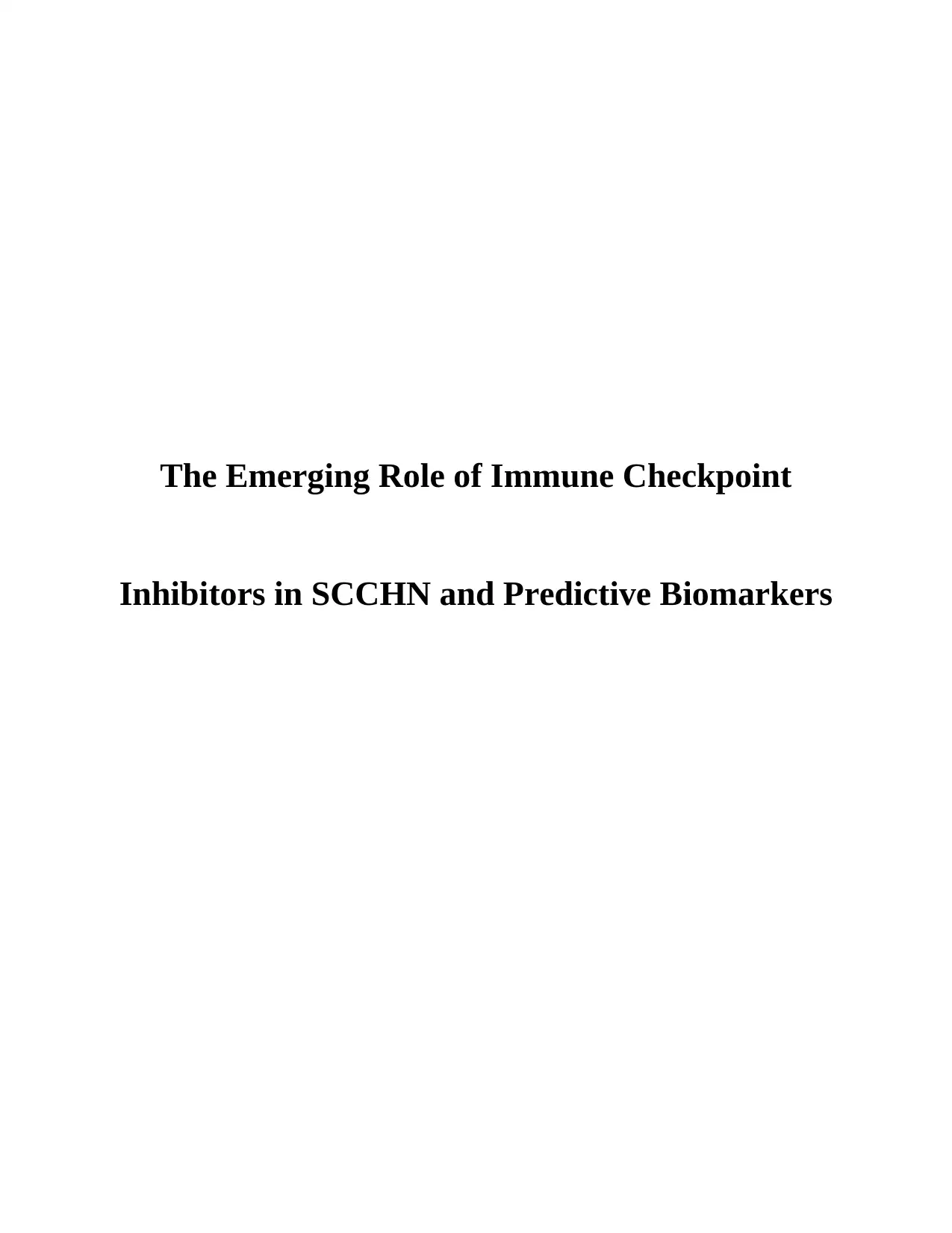
The Emerging Role of Immune Checkpoint
Inhibitors in SCCHN and Predictive Biomarkers
Inhibitors in SCCHN and Predictive Biomarkers
Paraphrase This Document
Need a fresh take? Get an instant paraphrase of this document with our AI Paraphraser
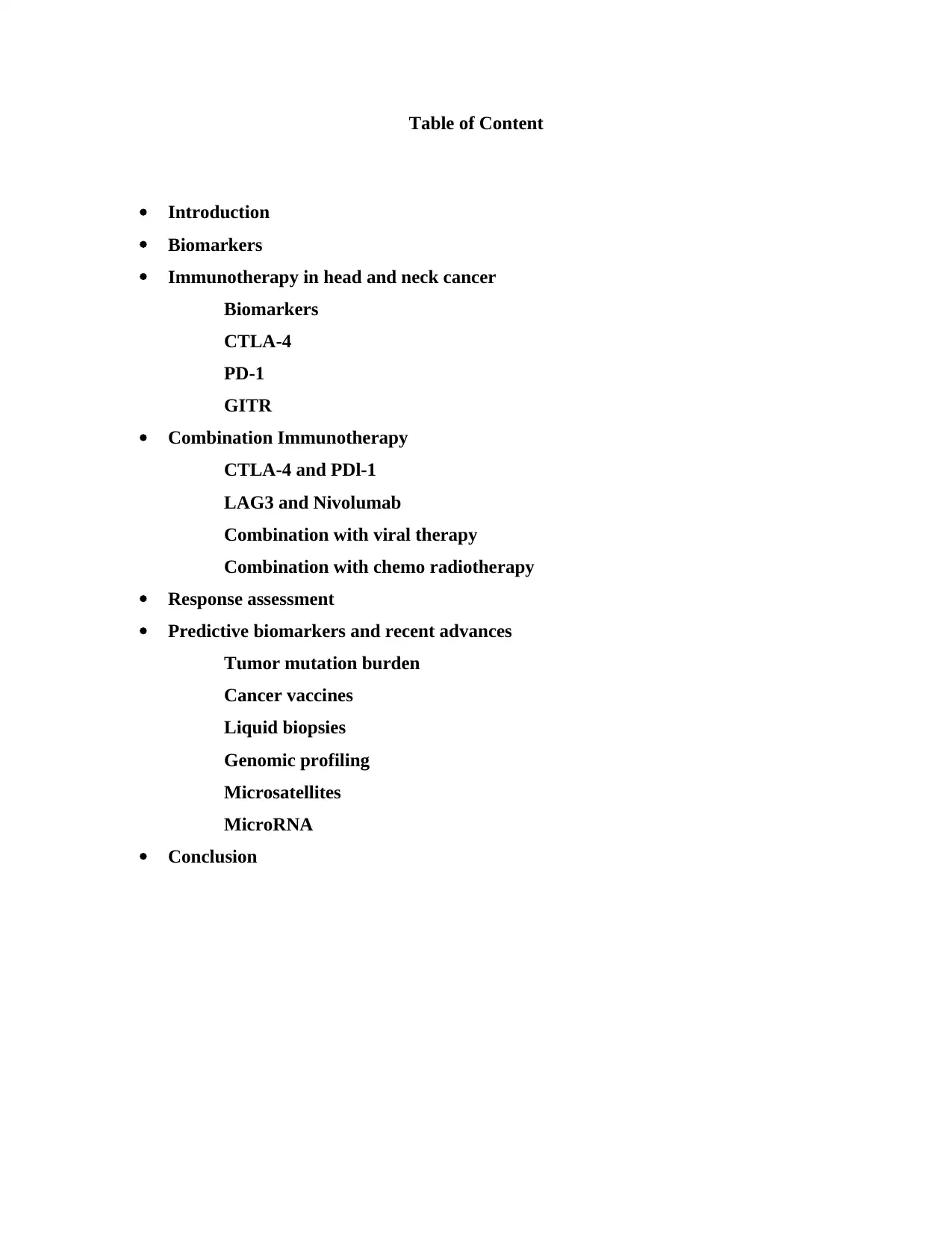
Table of Content
Introduction
Biomarkers
Immunotherapy in head and neck cancer
Biomarkers
CTLA-4
PD-1
GITR
Combination Immunotherapy
CTLA-4 and PDl-1
LAG3 and Nivolumab
Combination with viral therapy
Combination with chemo radiotherapy
Response assessment
Predictive biomarkers and recent advances
Tumor mutation burden
Cancer vaccines
Liquid biopsies
Genomic profiling
Microsatellites
MicroRNA
Conclusion
Introduction
Biomarkers
Immunotherapy in head and neck cancer
Biomarkers
CTLA-4
PD-1
GITR
Combination Immunotherapy
CTLA-4 and PDl-1
LAG3 and Nivolumab
Combination with viral therapy
Combination with chemo radiotherapy
Response assessment
Predictive biomarkers and recent advances
Tumor mutation burden
Cancer vaccines
Liquid biopsies
Genomic profiling
Microsatellites
MicroRNA
Conclusion
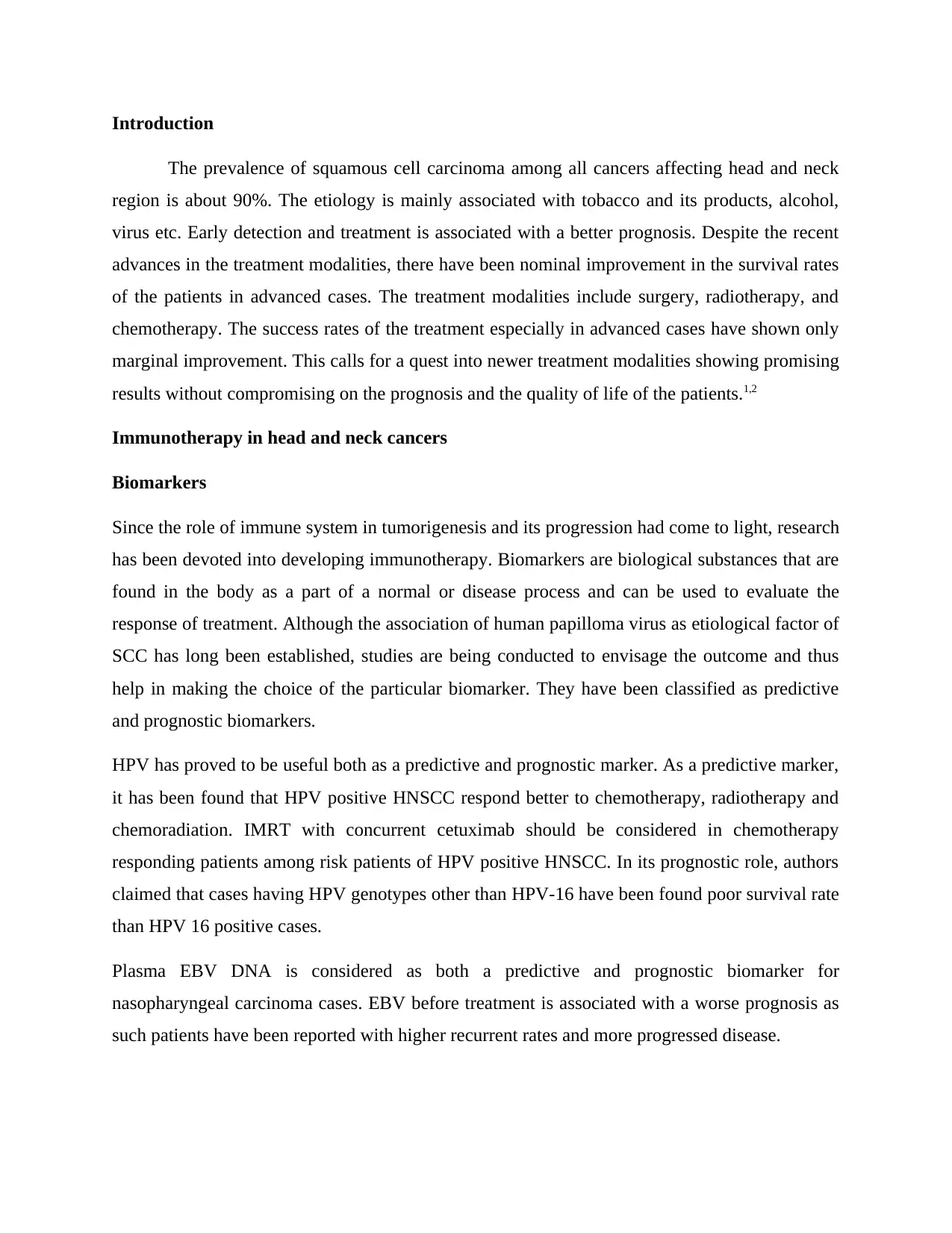
Introduction
The prevalence of squamous cell carcinoma among all cancers affecting head and neck
region is about 90%. The etiology is mainly associated with tobacco and its products, alcohol,
virus etc. Early detection and treatment is associated with a better prognosis. Despite the recent
advances in the treatment modalities, there have been nominal improvement in the survival rates
of the patients in advanced cases. The treatment modalities include surgery, radiotherapy, and
chemotherapy. The success rates of the treatment especially in advanced cases have shown only
marginal improvement. This calls for a quest into newer treatment modalities showing promising
results without compromising on the prognosis and the quality of life of the patients.1,2
Immunotherapy in head and neck cancers
Biomarkers
Since the role of immune system in tumorigenesis and its progression had come to light, research
has been devoted into developing immunotherapy. Biomarkers are biological substances that are
found in the body as a part of a normal or disease process and can be used to evaluate the
response of treatment. Although the association of human papilloma virus as etiological factor of
SCC has long been established, studies are being conducted to envisage the outcome and thus
help in making the choice of the particular biomarker. They have been classified as predictive
and prognostic biomarkers.
HPV has proved to be useful both as a predictive and prognostic marker. As a predictive marker,
it has been found that HPV positive HNSCC respond better to chemotherapy, radiotherapy and
chemoradiation. IMRT with concurrent cetuximab should be considered in chemotherapy
responding patients among risk patients of HPV positive HNSCC. In its prognostic role, authors
claimed that cases having HPV genotypes other than HPV-16 have been found poor survival rate
than HPV 16 positive cases.
Plasma EBV DNA is considered as both a predictive and prognostic biomarker for
nasopharyngeal carcinoma cases. EBV before treatment is associated with a worse prognosis as
such patients have been reported with higher recurrent rates and more progressed disease.
The prevalence of squamous cell carcinoma among all cancers affecting head and neck
region is about 90%. The etiology is mainly associated with tobacco and its products, alcohol,
virus etc. Early detection and treatment is associated with a better prognosis. Despite the recent
advances in the treatment modalities, there have been nominal improvement in the survival rates
of the patients in advanced cases. The treatment modalities include surgery, radiotherapy, and
chemotherapy. The success rates of the treatment especially in advanced cases have shown only
marginal improvement. This calls for a quest into newer treatment modalities showing promising
results without compromising on the prognosis and the quality of life of the patients.1,2
Immunotherapy in head and neck cancers
Biomarkers
Since the role of immune system in tumorigenesis and its progression had come to light, research
has been devoted into developing immunotherapy. Biomarkers are biological substances that are
found in the body as a part of a normal or disease process and can be used to evaluate the
response of treatment. Although the association of human papilloma virus as etiological factor of
SCC has long been established, studies are being conducted to envisage the outcome and thus
help in making the choice of the particular biomarker. They have been classified as predictive
and prognostic biomarkers.
HPV has proved to be useful both as a predictive and prognostic marker. As a predictive marker,
it has been found that HPV positive HNSCC respond better to chemotherapy, radiotherapy and
chemoradiation. IMRT with concurrent cetuximab should be considered in chemotherapy
responding patients among risk patients of HPV positive HNSCC. In its prognostic role, authors
claimed that cases having HPV genotypes other than HPV-16 have been found poor survival rate
than HPV 16 positive cases.
Plasma EBV DNA is considered as both a predictive and prognostic biomarker for
nasopharyngeal carcinoma cases. EBV before treatment is associated with a worse prognosis as
such patients have been reported with higher recurrent rates and more progressed disease.
⊘ This is a preview!⊘
Do you want full access?
Subscribe today to unlock all pages.

Trusted by 1+ million students worldwide
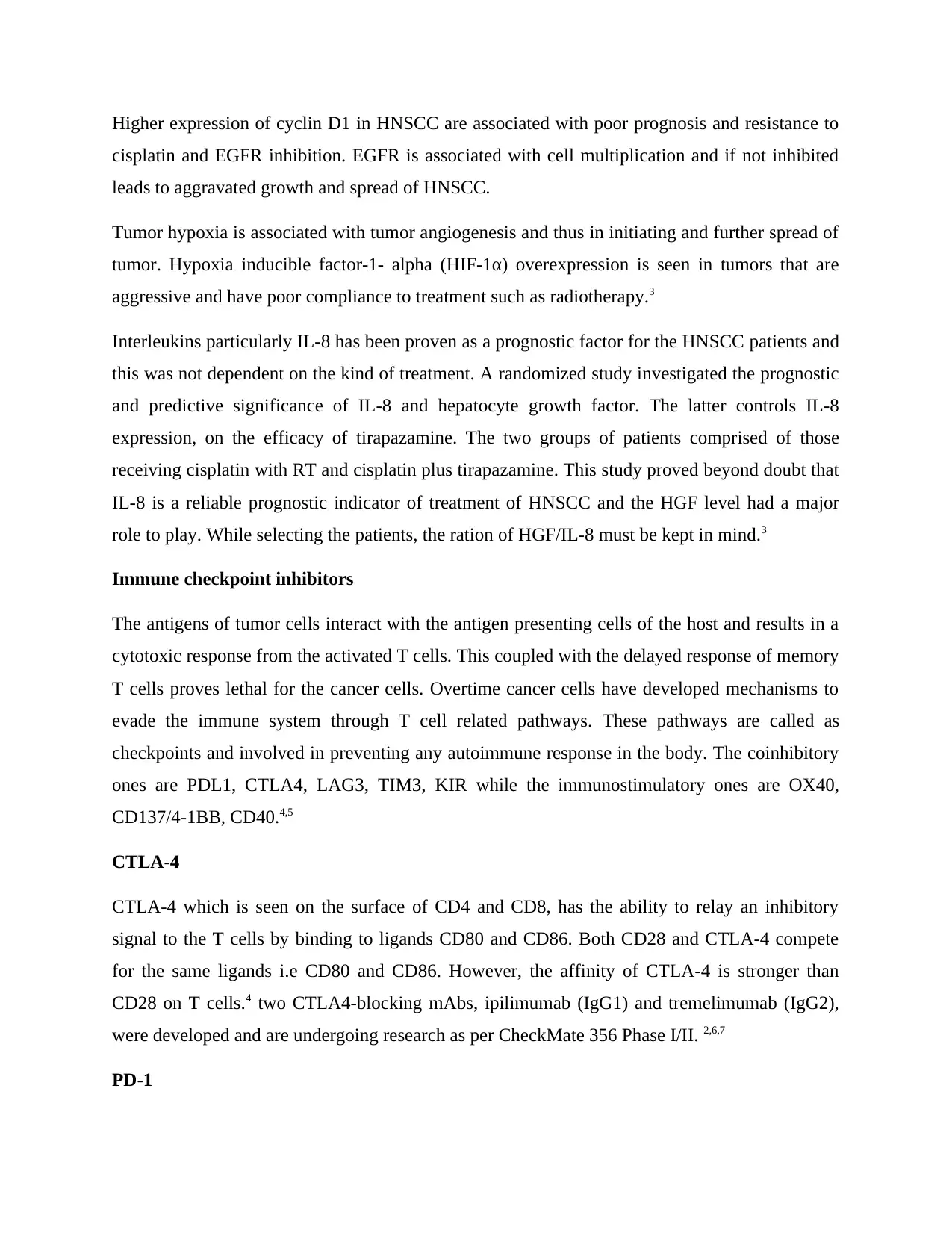
Higher expression of cyclin D1 in HNSCC are associated with poor prognosis and resistance to
cisplatin and EGFR inhibition. EGFR is associated with cell multiplication and if not inhibited
leads to aggravated growth and spread of HNSCC.
Tumor hypoxia is associated with tumor angiogenesis and thus in initiating and further spread of
tumor. Hypoxia inducible factor-1- alpha (HIF-1α) overexpression is seen in tumors that are
aggressive and have poor compliance to treatment such as radiotherapy.3
Interleukins particularly IL-8 has been proven as a prognostic factor for the HNSCC patients and
this was not dependent on the kind of treatment. A randomized study investigated the prognostic
and predictive significance of IL-8 and hepatocyte growth factor. The latter controls IL-8
expression, on the efficacy of tirapazamine. The two groups of patients comprised of those
receiving cisplatin with RT and cisplatin plus tirapazamine. This study proved beyond doubt that
IL-8 is a reliable prognostic indicator of treatment of HNSCC and the HGF level had a major
role to play. While selecting the patients, the ration of HGF/IL-8 must be kept in mind.3
Immune checkpoint inhibitors
The antigens of tumor cells interact with the antigen presenting cells of the host and results in a
cytotoxic response from the activated T cells. This coupled with the delayed response of memory
T cells proves lethal for the cancer cells. Overtime cancer cells have developed mechanisms to
evade the immune system through T cell related pathways. These pathways are called as
checkpoints and involved in preventing any autoimmune response in the body. The coinhibitory
ones are PDL1, CTLA4, LAG3, TIM3, KIR while the immunostimulatory ones are OX40,
CD137/4-1BB, CD40.4,5
CTLA-4
CTLA-4 which is seen on the surface of CD4 and CD8, has the ability to relay an inhibitory
signal to the T cells by binding to ligands CD80 and CD86. Both CD28 and CTLA-4 compete
for the same ligands i.e CD80 and CD86. However, the affinity of CTLA-4 is stronger than
CD28 on T cells.4 two CTLA4-blocking mAbs, ipilimumab (IgG1) and tremelimumab (IgG2),
were developed and are undergoing research as per CheckMate 356 Phase I/II. 2,6,7
PD-1
cisplatin and EGFR inhibition. EGFR is associated with cell multiplication and if not inhibited
leads to aggravated growth and spread of HNSCC.
Tumor hypoxia is associated with tumor angiogenesis and thus in initiating and further spread of
tumor. Hypoxia inducible factor-1- alpha (HIF-1α) overexpression is seen in tumors that are
aggressive and have poor compliance to treatment such as radiotherapy.3
Interleukins particularly IL-8 has been proven as a prognostic factor for the HNSCC patients and
this was not dependent on the kind of treatment. A randomized study investigated the prognostic
and predictive significance of IL-8 and hepatocyte growth factor. The latter controls IL-8
expression, on the efficacy of tirapazamine. The two groups of patients comprised of those
receiving cisplatin with RT and cisplatin plus tirapazamine. This study proved beyond doubt that
IL-8 is a reliable prognostic indicator of treatment of HNSCC and the HGF level had a major
role to play. While selecting the patients, the ration of HGF/IL-8 must be kept in mind.3
Immune checkpoint inhibitors
The antigens of tumor cells interact with the antigen presenting cells of the host and results in a
cytotoxic response from the activated T cells. This coupled with the delayed response of memory
T cells proves lethal for the cancer cells. Overtime cancer cells have developed mechanisms to
evade the immune system through T cell related pathways. These pathways are called as
checkpoints and involved in preventing any autoimmune response in the body. The coinhibitory
ones are PDL1, CTLA4, LAG3, TIM3, KIR while the immunostimulatory ones are OX40,
CD137/4-1BB, CD40.4,5
CTLA-4
CTLA-4 which is seen on the surface of CD4 and CD8, has the ability to relay an inhibitory
signal to the T cells by binding to ligands CD80 and CD86. Both CD28 and CTLA-4 compete
for the same ligands i.e CD80 and CD86. However, the affinity of CTLA-4 is stronger than
CD28 on T cells.4 two CTLA4-blocking mAbs, ipilimumab (IgG1) and tremelimumab (IgG2),
were developed and are undergoing research as per CheckMate 356 Phase I/II. 2,6,7
PD-1
Paraphrase This Document
Need a fresh take? Get an instant paraphrase of this document with our AI Paraphraser
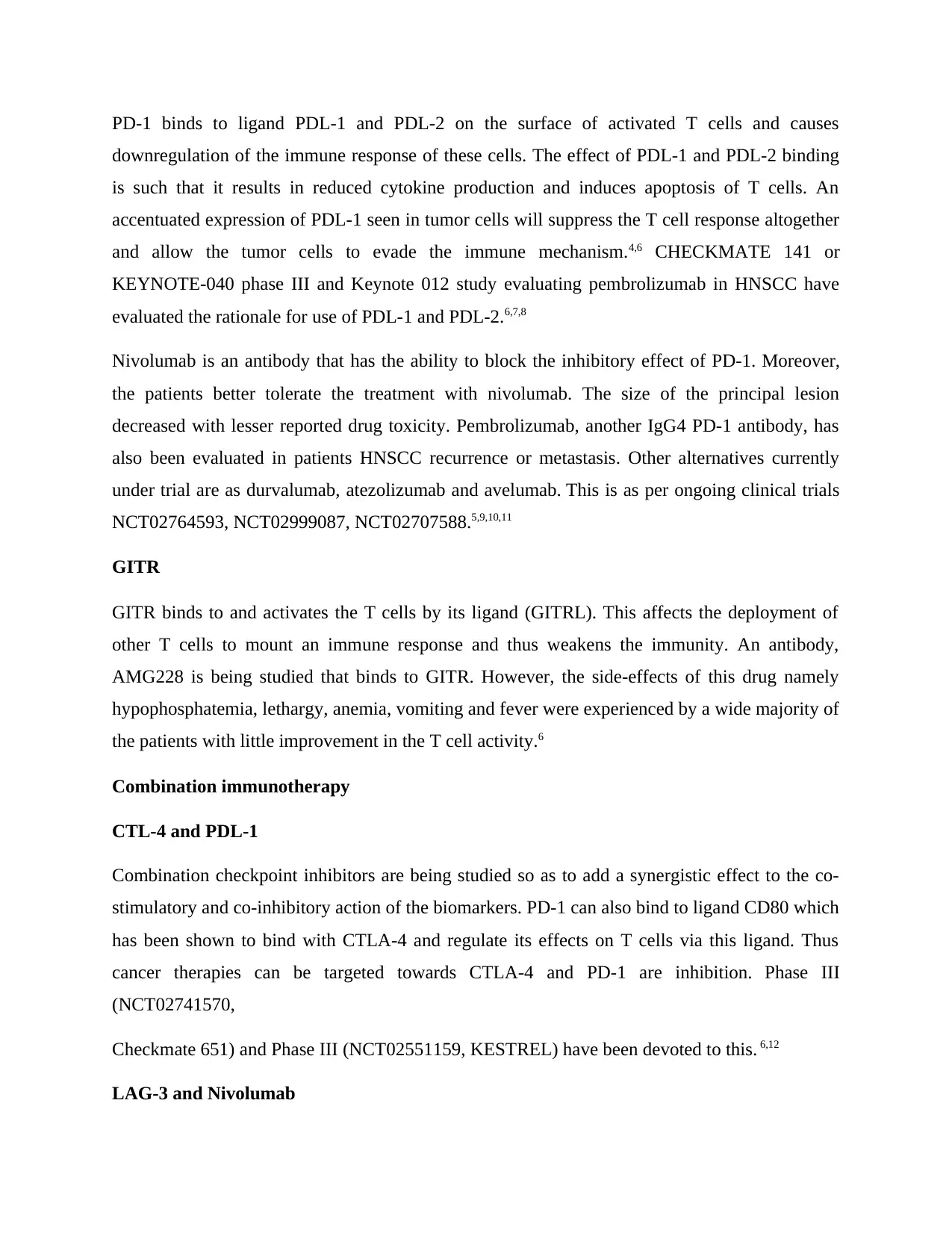
PD-1 binds to ligand PDL-1 and PDL-2 on the surface of activated T cells and causes
downregulation of the immune response of these cells. The effect of PDL-1 and PDL-2 binding
is such that it results in reduced cytokine production and induces apoptosis of T cells. An
accentuated expression of PDL-1 seen in tumor cells will suppress the T cell response altogether
and allow the tumor cells to evade the immune mechanism.4,6 CHECKMATE 141 or
KEYNOTE-040 phase III and Keynote 012 study evaluating pembrolizumab in HNSCC have
evaluated the rationale for use of PDL-1 and PDL-2.6,7,8
Nivolumab is an antibody that has the ability to block the inhibitory effect of PD-1. Moreover,
the patients better tolerate the treatment with nivolumab. The size of the principal lesion
decreased with lesser reported drug toxicity. Pembrolizumab, another IgG4 PD-1 antibody, has
also been evaluated in patients HNSCC recurrence or metastasis. Other alternatives currently
under trial are as durvalumab, atezolizumab and avelumab. This is as per ongoing clinical trials
NCT02764593, NCT02999087, NCT02707588.5,9,10,11
GITR
GITR binds to and activates the T cells by its ligand (GITRL). This affects the deployment of
other T cells to mount an immune response and thus weakens the immunity. An antibody,
AMG228 is being studied that binds to GITR. However, the side-effects of this drug namely
hypophosphatemia, lethargy, anemia, vomiting and fever were experienced by a wide majority of
the patients with little improvement in the T cell activity.6
Combination immunotherapy
CTL-4 and PDL-1
Combination checkpoint inhibitors are being studied so as to add a synergistic effect to the co-
stimulatory and co-inhibitory action of the biomarkers. PD-1 can also bind to ligand CD80 which
has been shown to bind with CTLA-4 and regulate its effects on T cells via this ligand. Thus
cancer therapies can be targeted towards CTLA-4 and PD-1 are inhibition. Phase III
(NCT02741570,
Checkmate 651) and Phase III (NCT02551159, KESTREL) have been devoted to this. 6,12
LAG-3 and Nivolumab
downregulation of the immune response of these cells. The effect of PDL-1 and PDL-2 binding
is such that it results in reduced cytokine production and induces apoptosis of T cells. An
accentuated expression of PDL-1 seen in tumor cells will suppress the T cell response altogether
and allow the tumor cells to evade the immune mechanism.4,6 CHECKMATE 141 or
KEYNOTE-040 phase III and Keynote 012 study evaluating pembrolizumab in HNSCC have
evaluated the rationale for use of PDL-1 and PDL-2.6,7,8
Nivolumab is an antibody that has the ability to block the inhibitory effect of PD-1. Moreover,
the patients better tolerate the treatment with nivolumab. The size of the principal lesion
decreased with lesser reported drug toxicity. Pembrolizumab, another IgG4 PD-1 antibody, has
also been evaluated in patients HNSCC recurrence or metastasis. Other alternatives currently
under trial are as durvalumab, atezolizumab and avelumab. This is as per ongoing clinical trials
NCT02764593, NCT02999087, NCT02707588.5,9,10,11
GITR
GITR binds to and activates the T cells by its ligand (GITRL). This affects the deployment of
other T cells to mount an immune response and thus weakens the immunity. An antibody,
AMG228 is being studied that binds to GITR. However, the side-effects of this drug namely
hypophosphatemia, lethargy, anemia, vomiting and fever were experienced by a wide majority of
the patients with little improvement in the T cell activity.6
Combination immunotherapy
CTL-4 and PDL-1
Combination checkpoint inhibitors are being studied so as to add a synergistic effect to the co-
stimulatory and co-inhibitory action of the biomarkers. PD-1 can also bind to ligand CD80 which
has been shown to bind with CTLA-4 and regulate its effects on T cells via this ligand. Thus
cancer therapies can be targeted towards CTLA-4 and PD-1 are inhibition. Phase III
(NCT02741570,
Checkmate 651) and Phase III (NCT02551159, KESTREL) have been devoted to this. 6,12
LAG-3 and Nivolumab
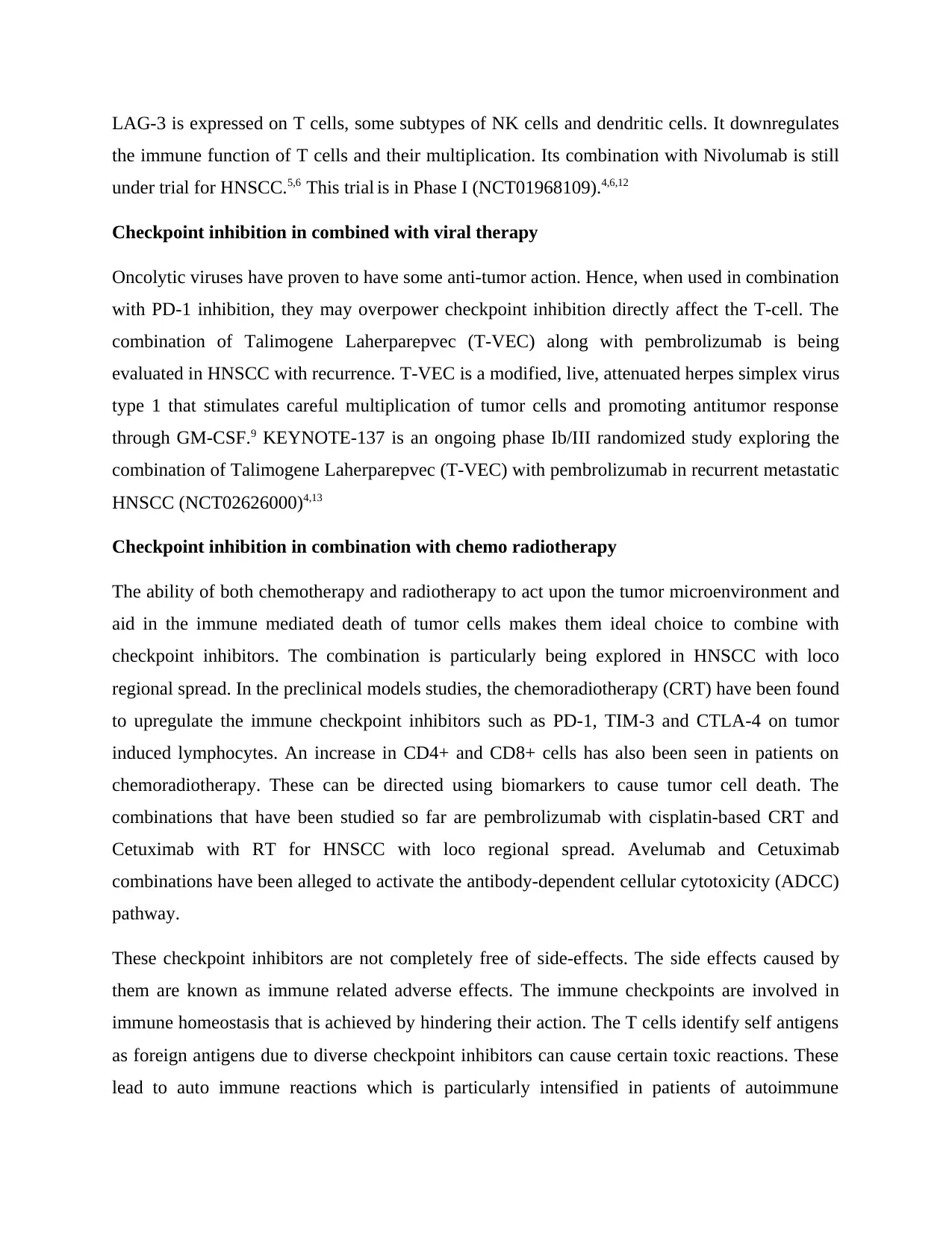
LAG-3 is expressed on T cells, some subtypes of NK cells and dendritic cells. It downregulates
the immune function of T cells and their multiplication. Its combination with Nivolumab is still
under trial for HNSCC.5,6 This trial is in Phase I (NCT01968109).4,6,12
Checkpoint inhibition in combined with viral therapy
Oncolytic viruses have proven to have some anti-tumor action. Hence, when used in combination
with PD-1 inhibition, they may overpower checkpoint inhibition directly affect the T-cell. The
combination of Talimogene Laherparepvec (T-VEC) along with pembrolizumab is being
evaluated in HNSCC with recurrence. T-VEC is a modified, live, attenuated herpes simplex virus
type 1 that stimulates careful multiplication of tumor cells and promoting antitumor response
through GM-CSF.9 KEYNOTE-137 is an ongoing phase Ib/III randomized study exploring the
combination of Talimogene Laherparepvec (T-VEC) with pembrolizumab in recurrent metastatic
HNSCC (NCT02626000)4,13
Checkpoint inhibition in combination with chemo radiotherapy
The ability of both chemotherapy and radiotherapy to act upon the tumor microenvironment and
aid in the immune mediated death of tumor cells makes them ideal choice to combine with
checkpoint inhibitors. The combination is particularly being explored in HNSCC with loco
regional spread. In the preclinical models studies, the chemoradiotherapy (CRT) have been found
to upregulate the immune checkpoint inhibitors such as PD-1, TIM-3 and CTLA-4 on tumor
induced lymphocytes. An increase in CD4+ and CD8+ cells has also been seen in patients on
chemoradiotherapy. These can be directed using biomarkers to cause tumor cell death. The
combinations that have been studied so far are pembrolizumab with cisplatin-based CRT and
Cetuximab with RT for HNSCC with loco regional spread. Avelumab and Cetuximab
combinations have been alleged to activate the antibody-dependent cellular cytotoxicity (ADCC)
pathway.
These checkpoint inhibitors are not completely free of side-effects. The side effects caused by
them are known as immune related adverse effects. The immune checkpoints are involved in
immune homeostasis that is achieved by hindering their action. The T cells identify self antigens
as foreign antigens due to diverse checkpoint inhibitors can cause certain toxic reactions. These
lead to auto immune reactions which is particularly intensified in patients of autoimmune
the immune function of T cells and their multiplication. Its combination with Nivolumab is still
under trial for HNSCC.5,6 This trial is in Phase I (NCT01968109).4,6,12
Checkpoint inhibition in combined with viral therapy
Oncolytic viruses have proven to have some anti-tumor action. Hence, when used in combination
with PD-1 inhibition, they may overpower checkpoint inhibition directly affect the T-cell. The
combination of Talimogene Laherparepvec (T-VEC) along with pembrolizumab is being
evaluated in HNSCC with recurrence. T-VEC is a modified, live, attenuated herpes simplex virus
type 1 that stimulates careful multiplication of tumor cells and promoting antitumor response
through GM-CSF.9 KEYNOTE-137 is an ongoing phase Ib/III randomized study exploring the
combination of Talimogene Laherparepvec (T-VEC) with pembrolizumab in recurrent metastatic
HNSCC (NCT02626000)4,13
Checkpoint inhibition in combination with chemo radiotherapy
The ability of both chemotherapy and radiotherapy to act upon the tumor microenvironment and
aid in the immune mediated death of tumor cells makes them ideal choice to combine with
checkpoint inhibitors. The combination is particularly being explored in HNSCC with loco
regional spread. In the preclinical models studies, the chemoradiotherapy (CRT) have been found
to upregulate the immune checkpoint inhibitors such as PD-1, TIM-3 and CTLA-4 on tumor
induced lymphocytes. An increase in CD4+ and CD8+ cells has also been seen in patients on
chemoradiotherapy. These can be directed using biomarkers to cause tumor cell death. The
combinations that have been studied so far are pembrolizumab with cisplatin-based CRT and
Cetuximab with RT for HNSCC with loco regional spread. Avelumab and Cetuximab
combinations have been alleged to activate the antibody-dependent cellular cytotoxicity (ADCC)
pathway.
These checkpoint inhibitors are not completely free of side-effects. The side effects caused by
them are known as immune related adverse effects. The immune checkpoints are involved in
immune homeostasis that is achieved by hindering their action. The T cells identify self antigens
as foreign antigens due to diverse checkpoint inhibitors can cause certain toxic reactions. These
lead to auto immune reactions which is particularly intensified in patients of autoimmune
⊘ This is a preview!⊘
Do you want full access?
Subscribe today to unlock all pages.

Trusted by 1+ million students worldwide
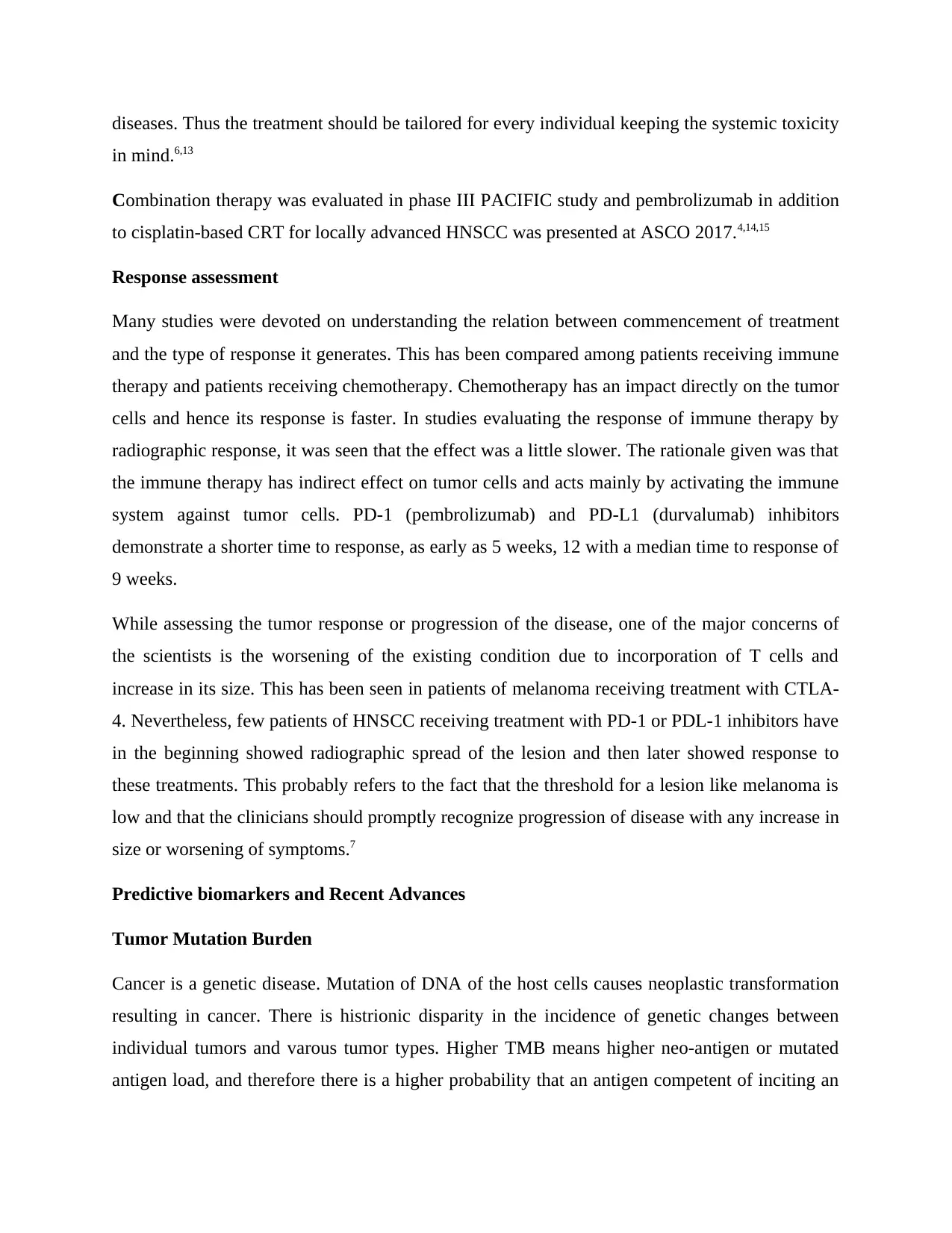
diseases. Thus the treatment should be tailored for every individual keeping the systemic toxicity
in mind.6,13
Combination therapy was evaluated in phase III PACIFIC study and pembrolizumab in addition
to cisplatin-based CRT for locally advanced HNSCC was presented at ASCO 2017.4,14,15
Response assessment
Many studies were devoted on understanding the relation between commencement of treatment
and the type of response it generates. This has been compared among patients receiving immune
therapy and patients receiving chemotherapy. Chemotherapy has an impact directly on the tumor
cells and hence its response is faster. In studies evaluating the response of immune therapy by
radiographic response, it was seen that the effect was a little slower. The rationale given was that
the immune therapy has indirect effect on tumor cells and acts mainly by activating the immune
system against tumor cells. PD-1 (pembrolizumab) and PD-L1 (durvalumab) inhibitors
demonstrate a shorter time to response, as early as 5 weeks, 12 with a median time to response of
9 weeks.
While assessing the tumor response or progression of the disease, one of the major concerns of
the scientists is the worsening of the existing condition due to incorporation of T cells and
increase in its size. This has been seen in patients of melanoma receiving treatment with CTLA-
4. Nevertheless, few patients of HNSCC receiving treatment with PD-1 or PDL-1 inhibitors have
in the beginning showed radiographic spread of the lesion and then later showed response to
these treatments. This probably refers to the fact that the threshold for a lesion like melanoma is
low and that the clinicians should promptly recognize progression of disease with any increase in
size or worsening of symptoms.7
Predictive biomarkers and Recent Advances
Tumor Mutation Burden
Cancer is a genetic disease. Mutation of DNA of the host cells causes neoplastic transformation
resulting in cancer. There is histrionic disparity in the incidence of genetic changes between
individual tumors and varous tumor types. Higher TMB means higher neo-antigen or mutated
antigen load, and therefore there is a higher probability that an antigen competent of inciting an
in mind.6,13
Combination therapy was evaluated in phase III PACIFIC study and pembrolizumab in addition
to cisplatin-based CRT for locally advanced HNSCC was presented at ASCO 2017.4,14,15
Response assessment
Many studies were devoted on understanding the relation between commencement of treatment
and the type of response it generates. This has been compared among patients receiving immune
therapy and patients receiving chemotherapy. Chemotherapy has an impact directly on the tumor
cells and hence its response is faster. In studies evaluating the response of immune therapy by
radiographic response, it was seen that the effect was a little slower. The rationale given was that
the immune therapy has indirect effect on tumor cells and acts mainly by activating the immune
system against tumor cells. PD-1 (pembrolizumab) and PD-L1 (durvalumab) inhibitors
demonstrate a shorter time to response, as early as 5 weeks, 12 with a median time to response of
9 weeks.
While assessing the tumor response or progression of the disease, one of the major concerns of
the scientists is the worsening of the existing condition due to incorporation of T cells and
increase in its size. This has been seen in patients of melanoma receiving treatment with CTLA-
4. Nevertheless, few patients of HNSCC receiving treatment with PD-1 or PDL-1 inhibitors have
in the beginning showed radiographic spread of the lesion and then later showed response to
these treatments. This probably refers to the fact that the threshold for a lesion like melanoma is
low and that the clinicians should promptly recognize progression of disease with any increase in
size or worsening of symptoms.7
Predictive biomarkers and Recent Advances
Tumor Mutation Burden
Cancer is a genetic disease. Mutation of DNA of the host cells causes neoplastic transformation
resulting in cancer. There is histrionic disparity in the incidence of genetic changes between
individual tumors and varous tumor types. Higher TMB means higher neo-antigen or mutated
antigen load, and therefore there is a higher probability that an antigen competent of inciting an
Paraphrase This Document
Need a fresh take? Get an instant paraphrase of this document with our AI Paraphraser
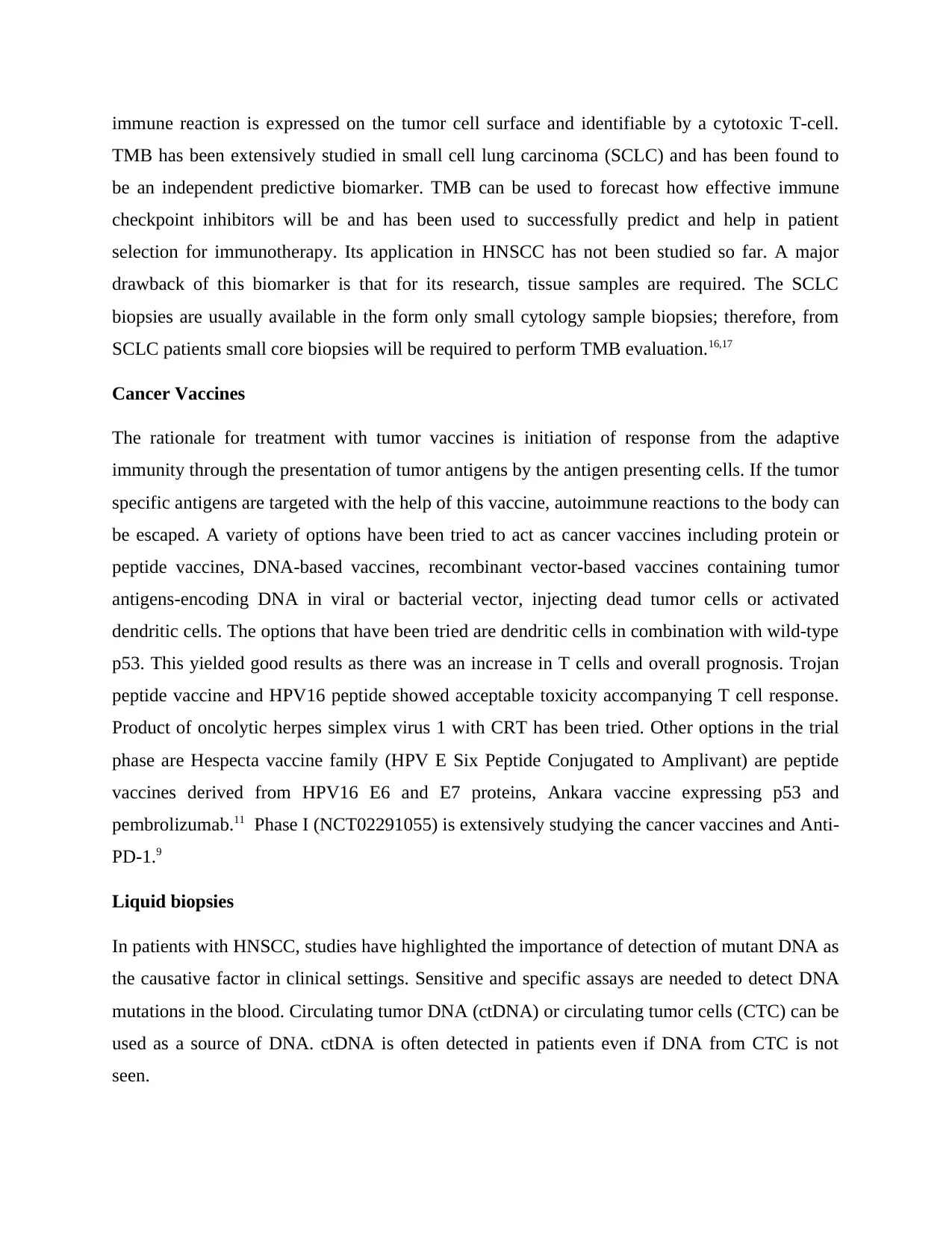
immune reaction is expressed on the tumor cell surface and identifiable by a cytotoxic T-cell.
TMB has been extensively studied in small cell lung carcinoma (SCLC) and has been found to
be an independent predictive biomarker. TMB can be used to forecast how effective immune
checkpoint inhibitors will be and has been used to successfully predict and help in patient
selection for immunotherapy. Its application in HNSCC has not been studied so far. A major
drawback of this biomarker is that for its research, tissue samples are required. The SCLC
biopsies are usually available in the form only small cytology sample biopsies; therefore, from
SCLC patients small core biopsies will be required to perform TMB evaluation.16,17
Cancer Vaccines
The rationale for treatment with tumor vaccines is initiation of response from the adaptive
immunity through the presentation of tumor antigens by the antigen presenting cells. If the tumor
specific antigens are targeted with the help of this vaccine, autoimmune reactions to the body can
be escaped. A variety of options have been tried to act as cancer vaccines including protein or
peptide vaccines, DNA-based vaccines, recombinant vector-based vaccines containing tumor
antigens-encoding DNA in viral or bacterial vector, injecting dead tumor cells or activated
dendritic cells. The options that have been tried are dendritic cells in combination with wild-type
p53. This yielded good results as there was an increase in T cells and overall prognosis. Trojan
peptide vaccine and HPV16 peptide showed acceptable toxicity accompanying T cell response.
Product of oncolytic herpes simplex virus 1 with CRT has been tried. Other options in the trial
phase are Hespecta vaccine family (HPV E Six Peptide Conjugated to Amplivant) are peptide
vaccines derived from HPV16 E6 and E7 proteins, Ankara vaccine expressing p53 and
pembrolizumab.11 Phase I (NCT02291055) is extensively studying the cancer vaccines and Anti-
PD-1.9
Liquid biopsies
In patients with HNSCC, studies have highlighted the importance of detection of mutant DNA as
the causative factor in clinical settings. Sensitive and specific assays are needed to detect DNA
mutations in the blood. Circulating tumor DNA (ctDNA) or circulating tumor cells (CTC) can be
used as a source of DNA. ctDNA is often detected in patients even if DNA from CTC is not
seen.
TMB has been extensively studied in small cell lung carcinoma (SCLC) and has been found to
be an independent predictive biomarker. TMB can be used to forecast how effective immune
checkpoint inhibitors will be and has been used to successfully predict and help in patient
selection for immunotherapy. Its application in HNSCC has not been studied so far. A major
drawback of this biomarker is that for its research, tissue samples are required. The SCLC
biopsies are usually available in the form only small cytology sample biopsies; therefore, from
SCLC patients small core biopsies will be required to perform TMB evaluation.16,17
Cancer Vaccines
The rationale for treatment with tumor vaccines is initiation of response from the adaptive
immunity through the presentation of tumor antigens by the antigen presenting cells. If the tumor
specific antigens are targeted with the help of this vaccine, autoimmune reactions to the body can
be escaped. A variety of options have been tried to act as cancer vaccines including protein or
peptide vaccines, DNA-based vaccines, recombinant vector-based vaccines containing tumor
antigens-encoding DNA in viral or bacterial vector, injecting dead tumor cells or activated
dendritic cells. The options that have been tried are dendritic cells in combination with wild-type
p53. This yielded good results as there was an increase in T cells and overall prognosis. Trojan
peptide vaccine and HPV16 peptide showed acceptable toxicity accompanying T cell response.
Product of oncolytic herpes simplex virus 1 with CRT has been tried. Other options in the trial
phase are Hespecta vaccine family (HPV E Six Peptide Conjugated to Amplivant) are peptide
vaccines derived from HPV16 E6 and E7 proteins, Ankara vaccine expressing p53 and
pembrolizumab.11 Phase I (NCT02291055) is extensively studying the cancer vaccines and Anti-
PD-1.9
Liquid biopsies
In patients with HNSCC, studies have highlighted the importance of detection of mutant DNA as
the causative factor in clinical settings. Sensitive and specific assays are needed to detect DNA
mutations in the blood. Circulating tumor DNA (ctDNA) or circulating tumor cells (CTC) can be
used as a source of DNA. ctDNA is often detected in patients even if DNA from CTC is not
seen.
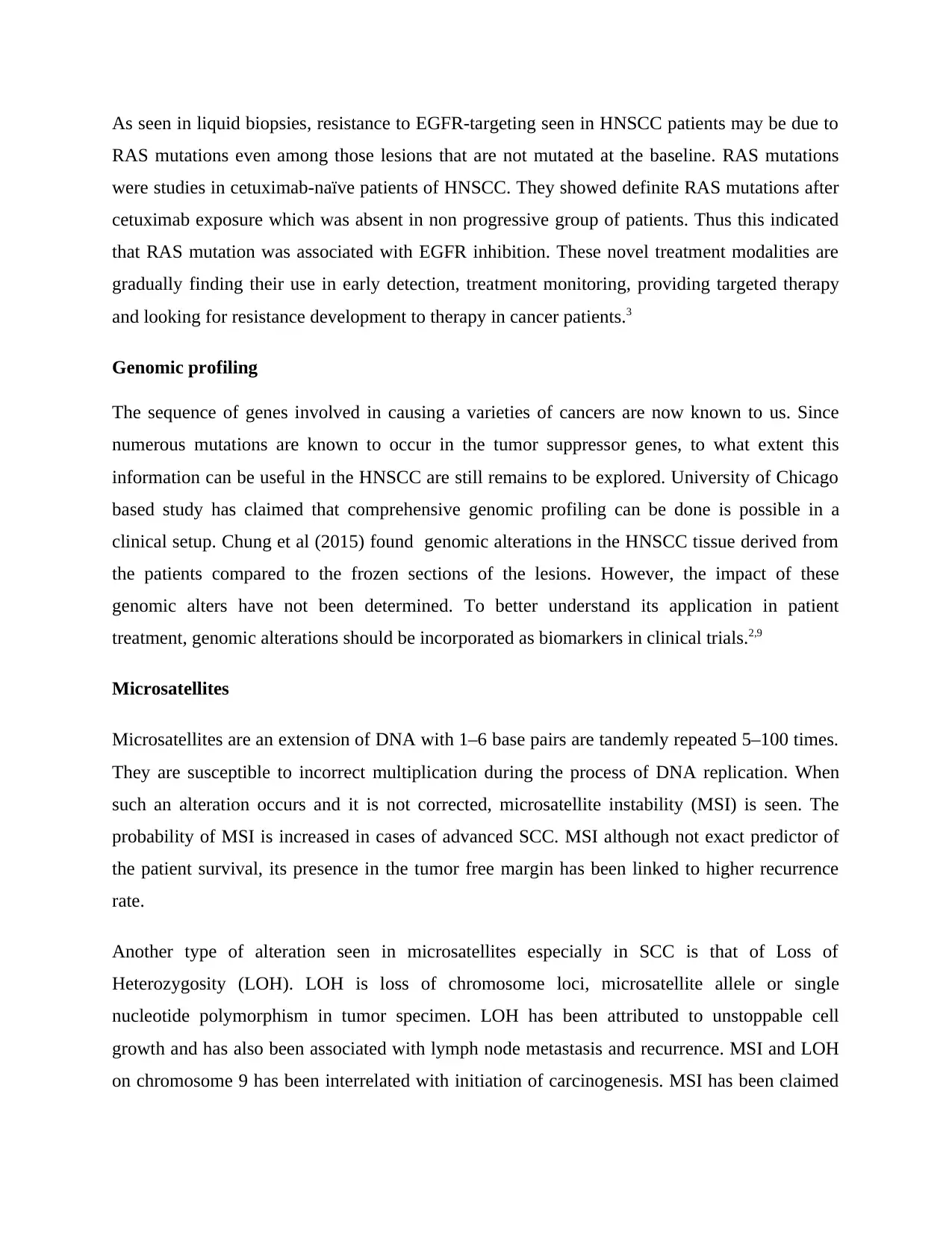
As seen in liquid biopsies, resistance to EGFR-targeting seen in HNSCC patients may be due to
RAS mutations even among those lesions that are not mutated at the baseline. RAS mutations
were studies in cetuximab-naïve patients of HNSCC. They showed definite RAS mutations after
cetuximab exposure which was absent in non progressive group of patients. Thus this indicated
that RAS mutation was associated with EGFR inhibition. These novel treatment modalities are
gradually finding their use in early detection, treatment monitoring, providing targeted therapy
and looking for resistance development to therapy in cancer patients.3
Genomic profiling
The sequence of genes involved in causing a varieties of cancers are now known to us. Since
numerous mutations are known to occur in the tumor suppressor genes, to what extent this
information can be useful in the HNSCC are still remains to be explored. University of Chicago
based study has claimed that comprehensive genomic profiling can be done is possible in a
clinical setup. Chung et al (2015) found genomic alterations in the HNSCC tissue derived from
the patients compared to the frozen sections of the lesions. However, the impact of these
genomic alters have not been determined. To better understand its application in patient
treatment, genomic alterations should be incorporated as biomarkers in clinical trials.2,9
Microsatellites
Microsatellites are an extension of DNA with 1–6 base pairs are tandemly repeated 5–100 times.
They are susceptible to incorrect multiplication during the process of DNA replication. When
such an alteration occurs and it is not corrected, microsatellite instability (MSI) is seen. The
probability of MSI is increased in cases of advanced SCC. MSI although not exact predictor of
the patient survival, its presence in the tumor free margin has been linked to higher recurrence
rate.
Another type of alteration seen in microsatellites especially in SCC is that of Loss of
Heterozygosity (LOH). LOH is loss of chromosome loci, microsatellite allele or single
nucleotide polymorphism in tumor specimen. LOH has been attributed to unstoppable cell
growth and has also been associated with lymph node metastasis and recurrence. MSI and LOH
on chromosome 9 has been interrelated with initiation of carcinogenesis. MSI has been claimed
RAS mutations even among those lesions that are not mutated at the baseline. RAS mutations
were studies in cetuximab-naïve patients of HNSCC. They showed definite RAS mutations after
cetuximab exposure which was absent in non progressive group of patients. Thus this indicated
that RAS mutation was associated with EGFR inhibition. These novel treatment modalities are
gradually finding their use in early detection, treatment monitoring, providing targeted therapy
and looking for resistance development to therapy in cancer patients.3
Genomic profiling
The sequence of genes involved in causing a varieties of cancers are now known to us. Since
numerous mutations are known to occur in the tumor suppressor genes, to what extent this
information can be useful in the HNSCC are still remains to be explored. University of Chicago
based study has claimed that comprehensive genomic profiling can be done is possible in a
clinical setup. Chung et al (2015) found genomic alterations in the HNSCC tissue derived from
the patients compared to the frozen sections of the lesions. However, the impact of these
genomic alters have not been determined. To better understand its application in patient
treatment, genomic alterations should be incorporated as biomarkers in clinical trials.2,9
Microsatellites
Microsatellites are an extension of DNA with 1–6 base pairs are tandemly repeated 5–100 times.
They are susceptible to incorrect multiplication during the process of DNA replication. When
such an alteration occurs and it is not corrected, microsatellite instability (MSI) is seen. The
probability of MSI is increased in cases of advanced SCC. MSI although not exact predictor of
the patient survival, its presence in the tumor free margin has been linked to higher recurrence
rate.
Another type of alteration seen in microsatellites especially in SCC is that of Loss of
Heterozygosity (LOH). LOH is loss of chromosome loci, microsatellite allele or single
nucleotide polymorphism in tumor specimen. LOH has been attributed to unstoppable cell
growth and has also been associated with lymph node metastasis and recurrence. MSI and LOH
on chromosome 9 has been interrelated with initiation of carcinogenesis. MSI has been claimed
⊘ This is a preview!⊘
Do you want full access?
Subscribe today to unlock all pages.

Trusted by 1+ million students worldwide
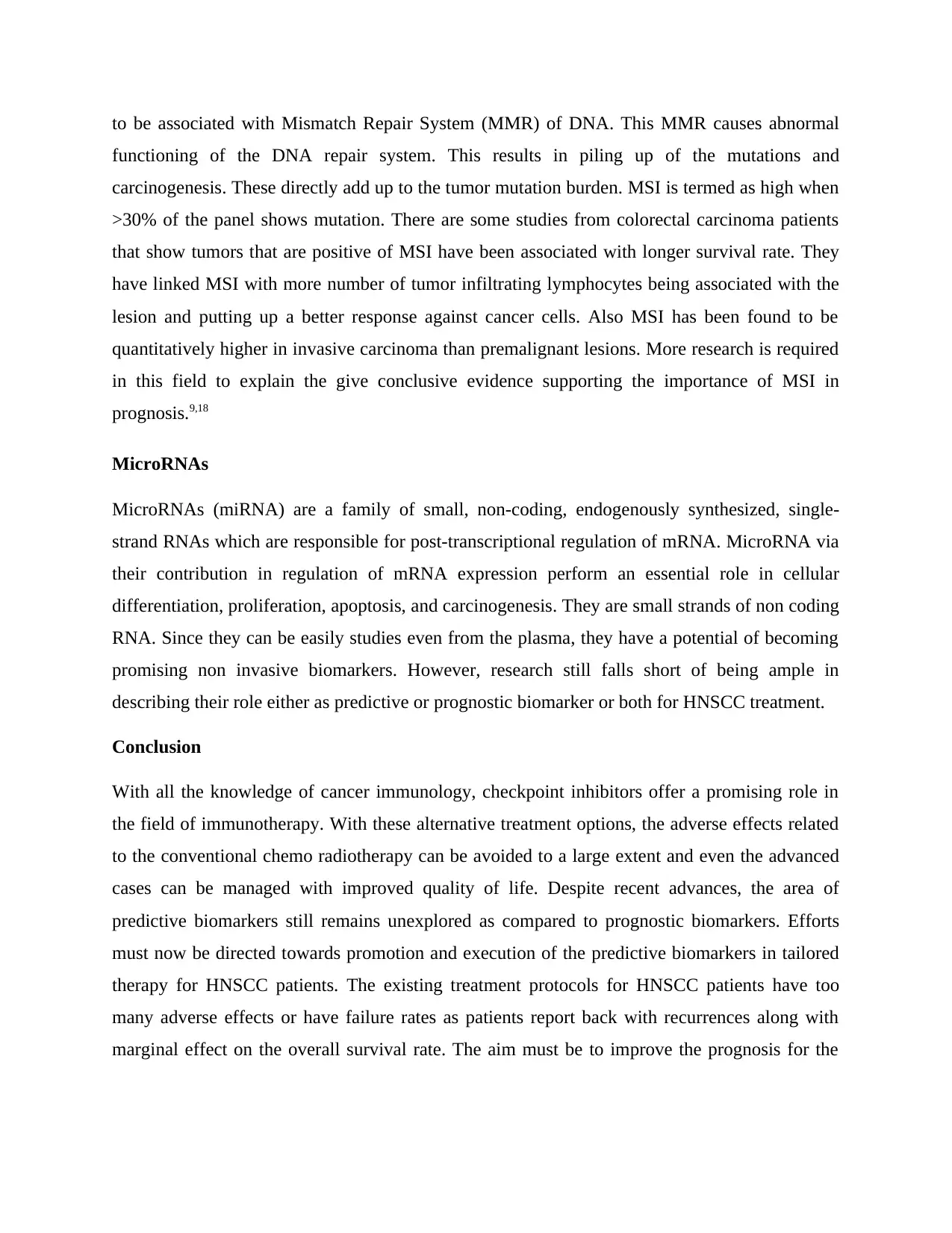
to be associated with Mismatch Repair System (MMR) of DNA. This MMR causes abnormal
functioning of the DNA repair system. This results in piling up of the mutations and
carcinogenesis. These directly add up to the tumor mutation burden. MSI is termed as high when
>30% of the panel shows mutation. There are some studies from colorectal carcinoma patients
that show tumors that are positive of MSI have been associated with longer survival rate. They
have linked MSI with more number of tumor infiltrating lymphocytes being associated with the
lesion and putting up a better response against cancer cells. Also MSI has been found to be
quantitatively higher in invasive carcinoma than premalignant lesions. More research is required
in this field to explain the give conclusive evidence supporting the importance of MSI in
prognosis.9,18
MicroRNAs
MicroRNAs (miRNA) are a family of small, non-coding, endogenously synthesized, single-
strand RNAs which are responsible for post-transcriptional regulation of mRNA. MicroRNA via
their contribution in regulation of mRNA expression perform an essential role in cellular
differentiation, proliferation, apoptosis, and carcinogenesis. They are small strands of non coding
RNA. Since they can be easily studies even from the plasma, they have a potential of becoming
promising non invasive biomarkers. However, research still falls short of being ample in
describing their role either as predictive or prognostic biomarker or both for HNSCC treatment.
Conclusion
With all the knowledge of cancer immunology, checkpoint inhibitors offer a promising role in
the field of immunotherapy. With these alternative treatment options, the adverse effects related
to the conventional chemo radiotherapy can be avoided to a large extent and even the advanced
cases can be managed with improved quality of life. Despite recent advances, the area of
predictive biomarkers still remains unexplored as compared to prognostic biomarkers. Efforts
must now be directed towards promotion and execution of the predictive biomarkers in tailored
therapy for HNSCC patients. The existing treatment protocols for HNSCC patients have too
many adverse effects or have failure rates as patients report back with recurrences along with
marginal effect on the overall survival rate. The aim must be to improve the prognosis for the
functioning of the DNA repair system. This results in piling up of the mutations and
carcinogenesis. These directly add up to the tumor mutation burden. MSI is termed as high when
>30% of the panel shows mutation. There are some studies from colorectal carcinoma patients
that show tumors that are positive of MSI have been associated with longer survival rate. They
have linked MSI with more number of tumor infiltrating lymphocytes being associated with the
lesion and putting up a better response against cancer cells. Also MSI has been found to be
quantitatively higher in invasive carcinoma than premalignant lesions. More research is required
in this field to explain the give conclusive evidence supporting the importance of MSI in
prognosis.9,18
MicroRNAs
MicroRNAs (miRNA) are a family of small, non-coding, endogenously synthesized, single-
strand RNAs which are responsible for post-transcriptional regulation of mRNA. MicroRNA via
their contribution in regulation of mRNA expression perform an essential role in cellular
differentiation, proliferation, apoptosis, and carcinogenesis. They are small strands of non coding
RNA. Since they can be easily studies even from the plasma, they have a potential of becoming
promising non invasive biomarkers. However, research still falls short of being ample in
describing their role either as predictive or prognostic biomarker or both for HNSCC treatment.
Conclusion
With all the knowledge of cancer immunology, checkpoint inhibitors offer a promising role in
the field of immunotherapy. With these alternative treatment options, the adverse effects related
to the conventional chemo radiotherapy can be avoided to a large extent and even the advanced
cases can be managed with improved quality of life. Despite recent advances, the area of
predictive biomarkers still remains unexplored as compared to prognostic biomarkers. Efforts
must now be directed towards promotion and execution of the predictive biomarkers in tailored
therapy for HNSCC patients. The existing treatment protocols for HNSCC patients have too
many adverse effects or have failure rates as patients report back with recurrences along with
marginal effect on the overall survival rate. The aim must be to improve the prognosis for the
Paraphrase This Document
Need a fresh take? Get an instant paraphrase of this document with our AI Paraphraser
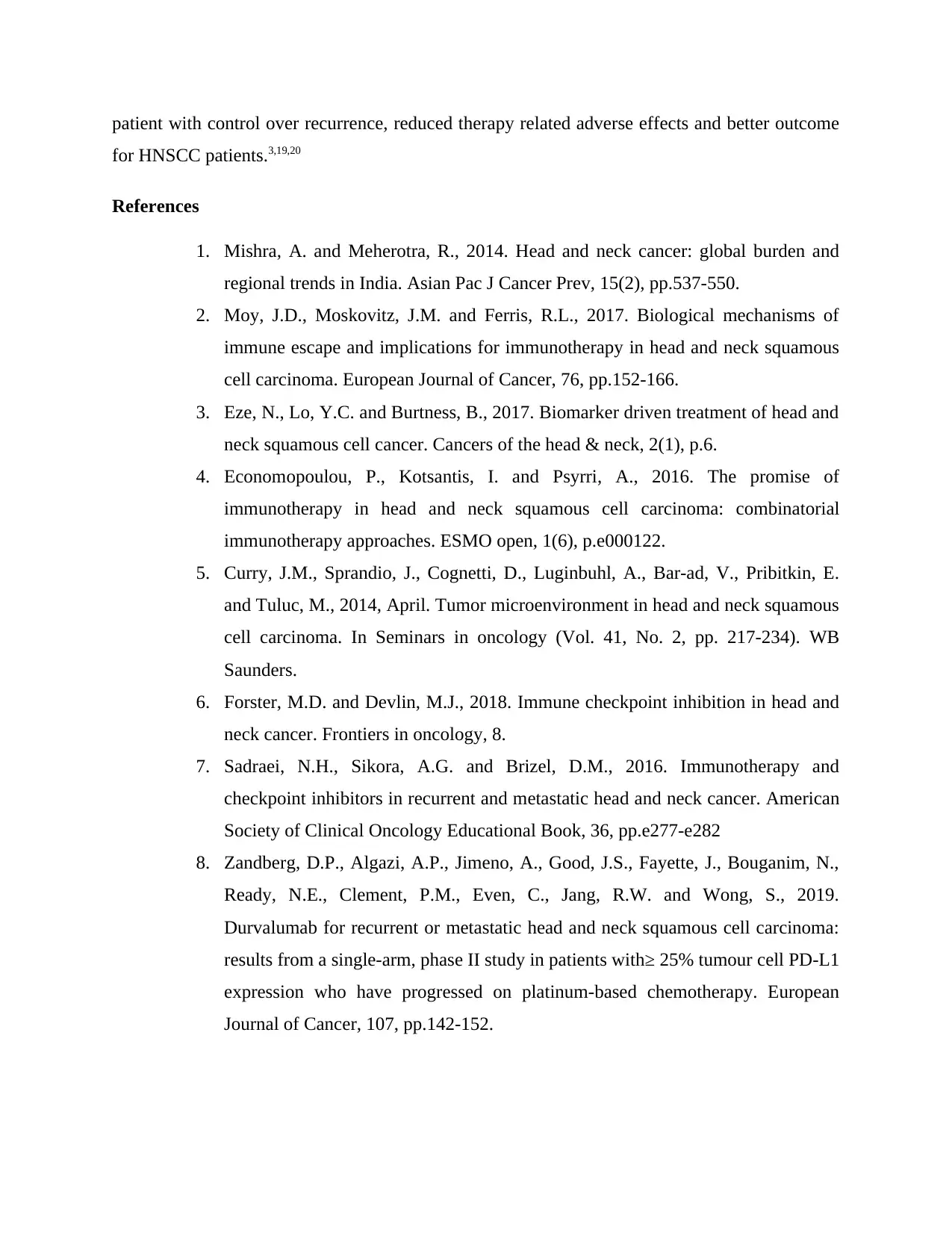
patient with control over recurrence, reduced therapy related adverse effects and better outcome
for HNSCC patients.3,19,20
References
1. Mishra, A. and Meherotra, R., 2014. Head and neck cancer: global burden and
regional trends in India. Asian Pac J Cancer Prev, 15(2), pp.537-550.
2. Moy, J.D., Moskovitz, J.M. and Ferris, R.L., 2017. Biological mechanisms of
immune escape and implications for immunotherapy in head and neck squamous
cell carcinoma. European Journal of Cancer, 76, pp.152-166.
3. Eze, N., Lo, Y.C. and Burtness, B., 2017. Biomarker driven treatment of head and
neck squamous cell cancer. Cancers of the head & neck, 2(1), p.6.
4. Economopoulou, P., Kotsantis, I. and Psyrri, A., 2016. The promise of
immunotherapy in head and neck squamous cell carcinoma: combinatorial
immunotherapy approaches. ESMO open, 1(6), p.e000122.
5. Curry, J.M., Sprandio, J., Cognetti, D., Luginbuhl, A., Bar-ad, V., Pribitkin, E.
and Tuluc, M., 2014, April. Tumor microenvironment in head and neck squamous
cell carcinoma. In Seminars in oncology (Vol. 41, No. 2, pp. 217-234). WB
Saunders.
6. Forster, M.D. and Devlin, M.J., 2018. Immune checkpoint inhibition in head and
neck cancer. Frontiers in oncology, 8.
7. Sadraei, N.H., Sikora, A.G. and Brizel, D.M., 2016. Immunotherapy and
checkpoint inhibitors in recurrent and metastatic head and neck cancer. American
Society of Clinical Oncology Educational Book, 36, pp.e277-e282
8. Zandberg, D.P., Algazi, A.P., Jimeno, A., Good, J.S., Fayette, J., Bouganim, N.,
Ready, N.E., Clement, P.M., Even, C., Jang, R.W. and Wong, S., 2019.
Durvalumab for recurrent or metastatic head and neck squamous cell carcinoma:
results from a single-arm, phase II study in patients with≥ 25% tumour cell PD-L1
expression who have progressed on platinum-based chemotherapy. European
Journal of Cancer, 107, pp.142-152.
for HNSCC patients.3,19,20
References
1. Mishra, A. and Meherotra, R., 2014. Head and neck cancer: global burden and
regional trends in India. Asian Pac J Cancer Prev, 15(2), pp.537-550.
2. Moy, J.D., Moskovitz, J.M. and Ferris, R.L., 2017. Biological mechanisms of
immune escape and implications for immunotherapy in head and neck squamous
cell carcinoma. European Journal of Cancer, 76, pp.152-166.
3. Eze, N., Lo, Y.C. and Burtness, B., 2017. Biomarker driven treatment of head and
neck squamous cell cancer. Cancers of the head & neck, 2(1), p.6.
4. Economopoulou, P., Kotsantis, I. and Psyrri, A., 2016. The promise of
immunotherapy in head and neck squamous cell carcinoma: combinatorial
immunotherapy approaches. ESMO open, 1(6), p.e000122.
5. Curry, J.M., Sprandio, J., Cognetti, D., Luginbuhl, A., Bar-ad, V., Pribitkin, E.
and Tuluc, M., 2014, April. Tumor microenvironment in head and neck squamous
cell carcinoma. In Seminars in oncology (Vol. 41, No. 2, pp. 217-234). WB
Saunders.
6. Forster, M.D. and Devlin, M.J., 2018. Immune checkpoint inhibition in head and
neck cancer. Frontiers in oncology, 8.
7. Sadraei, N.H., Sikora, A.G. and Brizel, D.M., 2016. Immunotherapy and
checkpoint inhibitors in recurrent and metastatic head and neck cancer. American
Society of Clinical Oncology Educational Book, 36, pp.e277-e282
8. Zandberg, D.P., Algazi, A.P., Jimeno, A., Good, J.S., Fayette, J., Bouganim, N.,
Ready, N.E., Clement, P.M., Even, C., Jang, R.W. and Wong, S., 2019.
Durvalumab for recurrent or metastatic head and neck squamous cell carcinoma:
results from a single-arm, phase II study in patients with≥ 25% tumour cell PD-L1
expression who have progressed on platinum-based chemotherapy. European
Journal of Cancer, 107, pp.142-152.
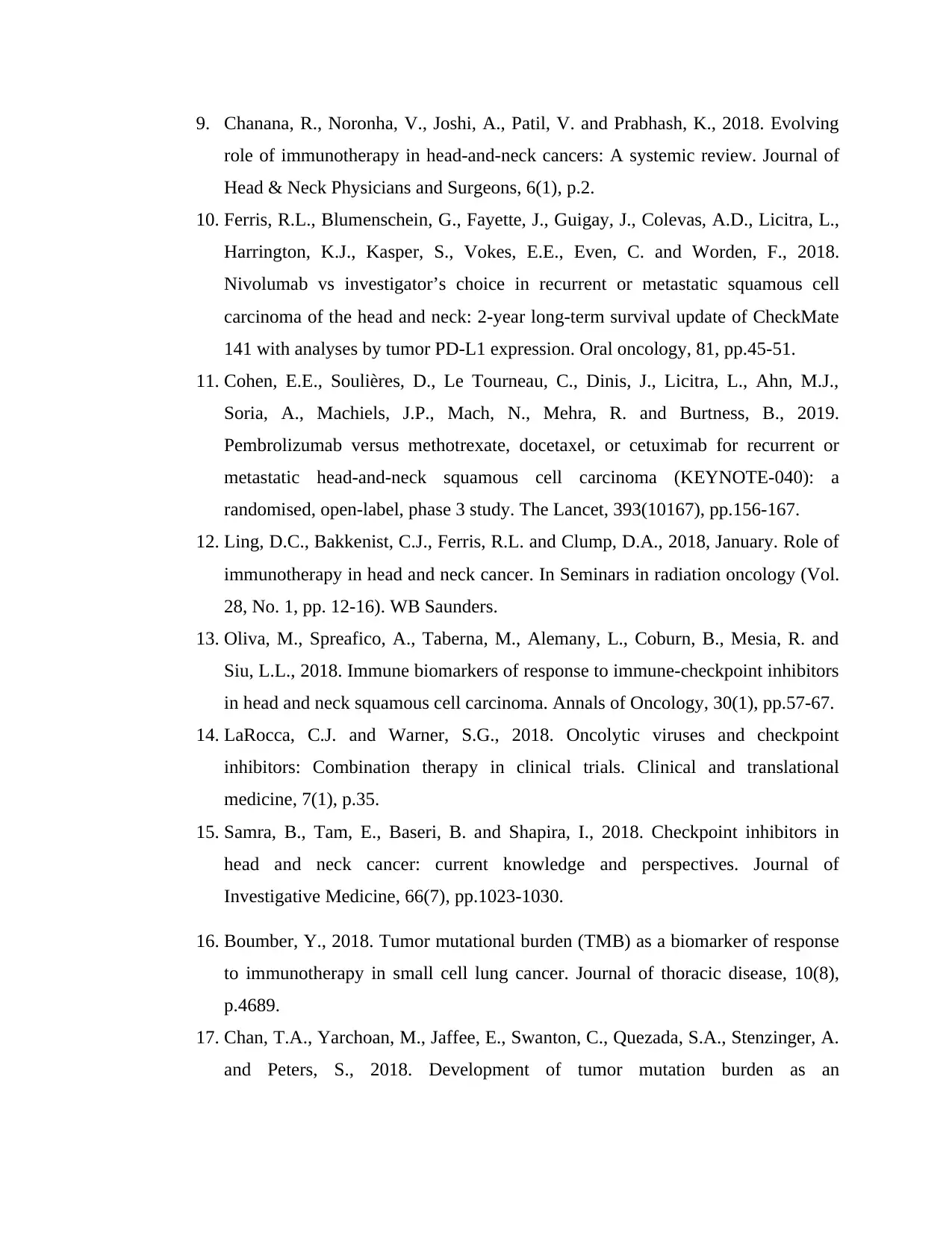
9. Chanana, R., Noronha, V., Joshi, A., Patil, V. and Prabhash, K., 2018. Evolving
role of immunotherapy in head-and-neck cancers: A systemic review. Journal of
Head & Neck Physicians and Surgeons, 6(1), p.2.
10. Ferris, R.L., Blumenschein, G., Fayette, J., Guigay, J., Colevas, A.D., Licitra, L.,
Harrington, K.J., Kasper, S., Vokes, E.E., Even, C. and Worden, F., 2018.
Nivolumab vs investigator’s choice in recurrent or metastatic squamous cell
carcinoma of the head and neck: 2-year long-term survival update of CheckMate
141 with analyses by tumor PD-L1 expression. Oral oncology, 81, pp.45-51.
11. Cohen, E.E., Soulières, D., Le Tourneau, C., Dinis, J., Licitra, L., Ahn, M.J.,
Soria, A., Machiels, J.P., Mach, N., Mehra, R. and Burtness, B., 2019.
Pembrolizumab versus methotrexate, docetaxel, or cetuximab for recurrent or
metastatic head-and-neck squamous cell carcinoma (KEYNOTE-040): a
randomised, open-label, phase 3 study. The Lancet, 393(10167), pp.156-167.
12. Ling, D.C., Bakkenist, C.J., Ferris, R.L. and Clump, D.A., 2018, January. Role of
immunotherapy in head and neck cancer. In Seminars in radiation oncology (Vol.
28, No. 1, pp. 12-16). WB Saunders.
13. Oliva, M., Spreafico, A., Taberna, M., Alemany, L., Coburn, B., Mesia, R. and
Siu, L.L., 2018. Immune biomarkers of response to immune-checkpoint inhibitors
in head and neck squamous cell carcinoma. Annals of Oncology, 30(1), pp.57-67.
14. LaRocca, C.J. and Warner, S.G., 2018. Oncolytic viruses and checkpoint
inhibitors: Combination therapy in clinical trials. Clinical and translational
medicine, 7(1), p.35.
15. Samra, B., Tam, E., Baseri, B. and Shapira, I., 2018. Checkpoint inhibitors in
head and neck cancer: current knowledge and perspectives. Journal of
Investigative Medicine, 66(7), pp.1023-1030.
16. Boumber, Y., 2018. Tumor mutational burden (TMB) as a biomarker of response
to immunotherapy in small cell lung cancer. Journal of thoracic disease, 10(8),
p.4689.
17. Chan, T.A., Yarchoan, M., Jaffee, E., Swanton, C., Quezada, S.A., Stenzinger, A.
and Peters, S., 2018. Development of tumor mutation burden as an
role of immunotherapy in head-and-neck cancers: A systemic review. Journal of
Head & Neck Physicians and Surgeons, 6(1), p.2.
10. Ferris, R.L., Blumenschein, G., Fayette, J., Guigay, J., Colevas, A.D., Licitra, L.,
Harrington, K.J., Kasper, S., Vokes, E.E., Even, C. and Worden, F., 2018.
Nivolumab vs investigator’s choice in recurrent or metastatic squamous cell
carcinoma of the head and neck: 2-year long-term survival update of CheckMate
141 with analyses by tumor PD-L1 expression. Oral oncology, 81, pp.45-51.
11. Cohen, E.E., Soulières, D., Le Tourneau, C., Dinis, J., Licitra, L., Ahn, M.J.,
Soria, A., Machiels, J.P., Mach, N., Mehra, R. and Burtness, B., 2019.
Pembrolizumab versus methotrexate, docetaxel, or cetuximab for recurrent or
metastatic head-and-neck squamous cell carcinoma (KEYNOTE-040): a
randomised, open-label, phase 3 study. The Lancet, 393(10167), pp.156-167.
12. Ling, D.C., Bakkenist, C.J., Ferris, R.L. and Clump, D.A., 2018, January. Role of
immunotherapy in head and neck cancer. In Seminars in radiation oncology (Vol.
28, No. 1, pp. 12-16). WB Saunders.
13. Oliva, M., Spreafico, A., Taberna, M., Alemany, L., Coburn, B., Mesia, R. and
Siu, L.L., 2018. Immune biomarkers of response to immune-checkpoint inhibitors
in head and neck squamous cell carcinoma. Annals of Oncology, 30(1), pp.57-67.
14. LaRocca, C.J. and Warner, S.G., 2018. Oncolytic viruses and checkpoint
inhibitors: Combination therapy in clinical trials. Clinical and translational
medicine, 7(1), p.35.
15. Samra, B., Tam, E., Baseri, B. and Shapira, I., 2018. Checkpoint inhibitors in
head and neck cancer: current knowledge and perspectives. Journal of
Investigative Medicine, 66(7), pp.1023-1030.
16. Boumber, Y., 2018. Tumor mutational burden (TMB) as a biomarker of response
to immunotherapy in small cell lung cancer. Journal of thoracic disease, 10(8),
p.4689.
17. Chan, T.A., Yarchoan, M., Jaffee, E., Swanton, C., Quezada, S.A., Stenzinger, A.
and Peters, S., 2018. Development of tumor mutation burden as an
⊘ This is a preview!⊘
Do you want full access?
Subscribe today to unlock all pages.

Trusted by 1+ million students worldwide
1 out of 13
Related Documents
Your All-in-One AI-Powered Toolkit for Academic Success.
+13062052269
info@desklib.com
Available 24*7 on WhatsApp / Email
![[object Object]](/_next/static/media/star-bottom.7253800d.svg)
Unlock your academic potential
Copyright © 2020–2025 A2Z Services. All Rights Reserved. Developed and managed by ZUCOL.



